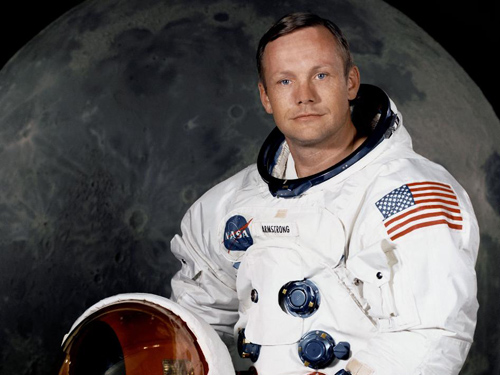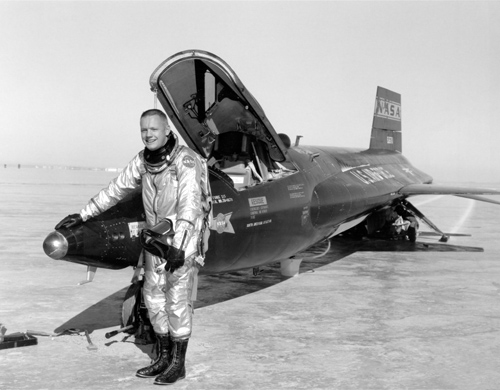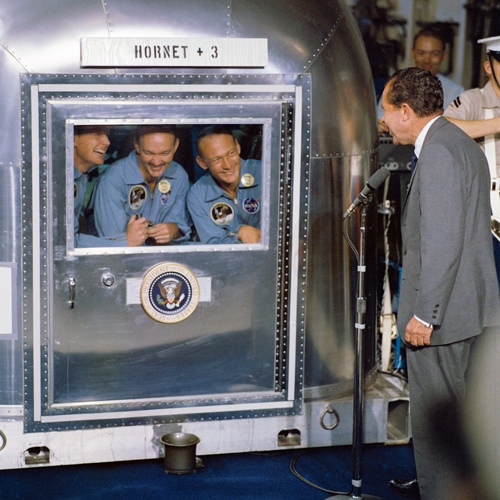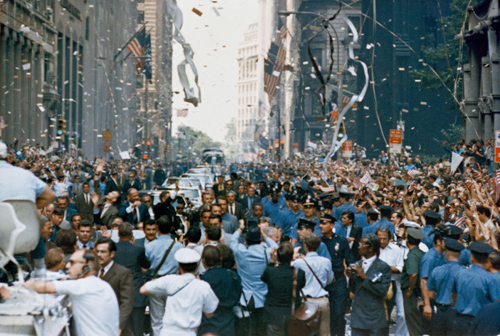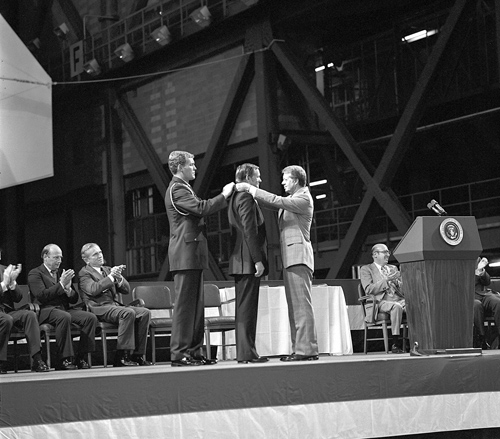Neil A. Armstrong, the first man to walk on the moon, was born in Wapakoneta, Ohio, on August 5, 1930. He began his NASA career in Ohio.
After serving as a naval aviator from 1949 to 1952, Armstrong joined the National Advisory Committee for Aeronautics (NACA) in 1955. His first assignment was with the NACA Lewis Research Center (now NASA Glenn) in Cleveland. Over the next 17 years, he was an engineer, test pilot, astronaut and administrator for NACA and its successor agency, the National Aeronautics and Space Administration (NASA).
As a research pilot at NASA’s Flight Research Center, Edwards, Calif., he was a project pilot on many pioneering high speed aircraft, including the well known, 4000-mph X-15. He has flown over 200 different models of aircraft, including jets, rockets, helicopters and gliders.
Armstrong transferred to astronaut status in 1962. He was assigned as command pilot for the Gemini 8 mission. Gemini 8 was launched on March 16, 1966, and Armstrong performed the first successful docking of two vehicles in space.
As spacecraft commander for Apollo 11, the first manned lunar landing mission, Armstrong gained the distinction of being the first man to land a craft on the moon and first to step on its surface.
Armstrong subsequently held the position of Deputy Associate Administrator for Aeronautics, NASA Headquarters, Washington, D.C. In this position, he was responsible for the coordination and management of overall NASA research and technology work related to aeronautics.
He was Professor of Aerospace Engineering at the University of Cincinnati between 1971-1979. During the years 1982-1992, Armstrong was chairman of Computing Technologies for Aviation, Inc., Charlottesville, Va.
He received a Bachelor of Science Degree in Aeronautical Engineering from Purdue University and a Master of Science in Aerospace Engineering from the University of Southern California. He holds honorary doctorates from a number of universities.
Armstrong was a Fellow of the Society of Experimental Test Pilots and the Royal Aeronautical Society; Honorary Fellow of the American Institute of Aeronautics and Astronautics, and the International Astronautics Federation.
He was a member of the National Academy of Engineering and the Academy of the Kingdom of Morocco. He served as a member of the National Commission on Space (1985-1986), as Vice-Chairman of the Presidential Commission on the Space Shuttle Challenger Accident (1986), and as Chairman of the Presidential Advisory Committee for the Peace Corps (1971-1973).
Armstrong was decorated by 17 countries. He was the recipient of many special honors, including the Presidential Medal of Freedom; the Congressional Gold Medal; the Congressional Space Medal of Honor; the Explorers Club Medal; the Robert H. Goddard Memorial Trophy; the NASA Distinguished Service Medal; the Harmon International Aviation Trophy; the Royal Geographic Society’s Gold Medal; the Federation Aeronautique Internationale’s Gold Space Medal; the American Astronautical Society Flight Achievement Award; the Robert J. Collier Trophy; the AIAA Astronautics Award; the Octave Chanute Award; and the John J. Montgomery Award.
Armstrong passed away on Aug. 25, 2012 following complications resulting from cardiovascular procedures. He was 82. August 2012
*Source: NASA
Portrait of Astronaut Neil A. Armstrong, commander of the Apollo 11 Lunar Landing mission in his space suit, with his helmet on the table in front of him. Behind him is a large photograph of the lunar surface. Image Credit: NASA
During re-entry from flight training at 207,000 feet in an X-15-3, Neil Armstrong inadvertently established a positive angle of attack during pull-out, and overshot Edwards Air Force Base in California, heading south at Mach 3 and 100,000 feet altitude. He finally managed to turn back while over the Rose Bowl in Pasadena, and had just enough energy to land on the south end of Rogers Dry Lake at Edwards. In the debriefing, someone asked how much clearance the X-15 had from the Joshua trees on the edge of the lakebed. “Oh, at least 100 feet…on either side,” said the chase pilot. Image Credit: NASA
Astronauts David R. Scott (left), Pilot; and, Neil A. Armstrong (right), Command Pilot, pose with model of the Gemini Spacecraft after being selected at the crew for the Gemini VIII mission. Image Credit: NASA
The Apollo 11 lunar landing mission crew, pictured from left to right, Neil A. Armstrong, commander; Michael Collins, command module pilot; and Edwin E. Aldrin Jr., lunar module pilot. Image Credit: NASA
Apollo 11 astronauts trained on Earth to take individual photographs in succession in order to create a series of frames that could be assembled into panoramic images. This frame from Aldrin’s panorama of the Apollo 11 landing site is the only good picture of mission commander Neil Armstrong on the lunar surface. Image Credit: NASA
President Richard M. Nixon was in the central Pacific recovery area to welcome the Apollo 11 astronauts aboard the USS Hornet, prime recovery ship for the historic Apollo 11 lunar landing mission. Already confined to the Mobile Quarantine Facility (MQF) are (left to right) Neil A. Armstrong, commander; Michael Collins, command module pilot; and Edwin E. Aldrin Jr., lunar module pilot. Apollo 11 splashed down at 11:49 a.m. (CDT), July 24, 1969, about 812 nautical miles southwest of Hawaii and only 12 nautical miles from the USS Hornet. Image Credit: NASA
New York City welcomes the Apollo 11 crew in a ticker tape parade down Broadway and Park Avenue. Pictured in the lead car, from the right, are astronauts Neil A. Armstrong, Michael Collins and Buzz Aldrin. The three astronauts teamed for the first manned lunar landing, on July 20, 1969. Image Credit: NASA
Astronaut Neil Armstrong received the first Congressional Space Medal of Honor from President Jimmy Carter, assisted by Captain Robert Peterson. Armstrong, one of six astronauts to be presented the medal during ceremonies held in the Vehicle Assembly Building, was awarded for his performance during the Gemini 8 mission and the Apollo 11 mission when he became the first human to set foot upon the moon. Armstrong died on Aug. 25, 2012, at the age of 82. Image Credit: NASA
Image Source: NASA

